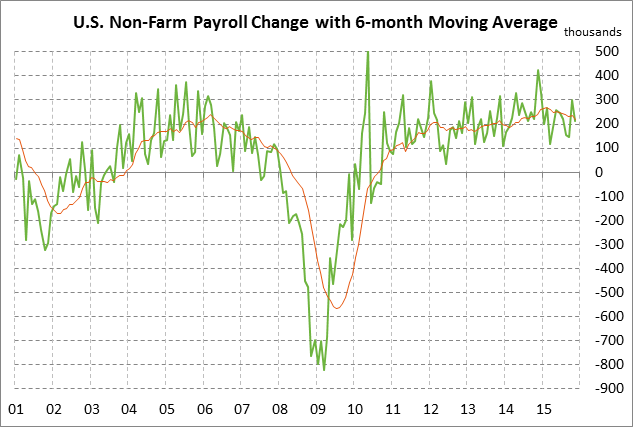- China’s regulator drops circuit breakers and lets the market float
- Payrolls are expected to show a solid increase that would somewhat offset concerns about Chinese turmoil
- U.S. consumer credit report expected to show that consumers remain confident enough to continue to boost their credit levels
China’s regulator drops circuit breakers and lets the market float — China’s security regulator yesterday suspended its circuit breaker system that resulted in daily trading halts this week on Monday and Thursday. The circuit breakers have caused investors to head for the door at the same time as they seek to avoid being locked-out from selling. The question now becomes how far the Chinese stock market will have to fall before sufficient buying emerges. The Shanghai Composite stock index on Thursday closed down -7.0% after trading was halted just 30 minutes into the trading session. The Shanghai Composite index this week (through Thursday) has so far plunged by -11.7%. Despite this week’s plunge, the Shanghai Composite is still +9.6% above the 1-year low posted in Aug 2015 and is up by more than +50% from the mid-2014 level that prevailed before the Chinese stock market bubble started to emerge in late 2014.
This week’s plunge in stocks has been driven by a lack of confidence in China’s securities regulators and the Chinese economy in general. The Chinese economy is clearly slowing and the markets do not believe the Chinese government’s economic statistics, meaning that at least some market participants are starting to assume the worst.
This week’s plunge in Chinese stocks has also been driven by the Chinese government’s renewed devaluation of the yuan. The weaker yuan will give a boost to exporters and the economy, but is negative for investors who are holding yuan-denominated investments. The devaluation of the yuan encourages investors to dump their yuan-denominated stocks and bonds and shift their capital out of China. There is concern about a panic stampede of capital out of China, which would starve the Chinese economy of investment capital. China saw an outflow of about $267 billion over the 3-month period of Sep-Nov as investors moved their capital overseas to seek better returns.
The yuan has now fallen by -1.5% this week and by an overall -3.8% since October, which is more than the -3% plunge seen last August when Chinese authorities engineered what they said at the time a one-time devaluation of the yuan. If the stock market volatility continues, the Chinese authorities will likely cry uncle and say that they are done with the yuan devaluation for the time being. That should help the Chinese stock market to at least temporarily stabilize.
Payrolls are expected to show a solid increase that would somewhat offset concerns about Chinese turmoil — The market is expecting today’s Dec payroll report to show an increase of +200,000, down mildly from Nov’s +211,000 and the 3-month moving average of +218,000. Expectations for today’s payroll report were bolstered by Wednesday’s Dec ADP report of +257,000, which was substantially stronger than market expectations of +195,000. As long as monthly payroll growth remains near or above +200,000, the Fed is likely to continue on a path of steadily raising interest rates, assuming the Chinese turmoil does not get worse.
Meanwhile, the market is expecting today’s Dec unemployment rate to be unchanged from the 8-year low of 5.0% seen in Oct-Nov. That is only +0.3 points above the FOMC’s mid-point forecast of 4.7% for the unemployment rate in 2016-18, illustrating that the U.S. labor market has nearly met the FOMC’s long-term target.
However, there are other measures of the labor market that remain weak and the unemployment rate has only fallen as far as it has because of a shrinking labor force. Indeed, the labor force participation rate in Sep/Oct fell to a 38-year low of 62.4% and rebounded to just 62.5% in Nov, indicating that only 62.5% of the U.S. population is engaged in the labor market with a job or looking for a job. That is sharply below the record high of 67.3% posted in early 2000. The U.S. labor market has been shrinking because (1) baby-boomers have started to retire, (2) many people went back to school while the economy was in the dumps or joined the underground economy, and (3) some people simply became discouraged about the job prospects and quit looking for a job altogether.
The Fed also remains concerned about the continued high level of long-term unemployment, which is a serious problem since those unemployed people become less employable as time goes on because they lose skills and contacts. The share of the long-term unemployed (i.e., unemployed 27 weeks or longer) was at 25.7% in October, which was a 6-1/4 year low but was still far above the pre-recession (2000-07) average of 17.5%.
U.S. consumer credit report expected to show that consumers remain confident enough to continue to boost their credit levels — The market is expecting today’s Nov U.S. consumer credit report to show an increase of +$18.5 billion, stronger than Oct’s increase of +$16.0 billion but mildly below the 12-month moving average of +$19.0 billion. U.S. consumer credit in general remains strong with the year-on-year increase in Oct matching the recent 4-year high of +7.0% y/y.
The strength in U.S. consumer credit continues to come mainly from auto and student loans as U.S. installment loan growth in October was up sharply by +7.9% y/y. U.S credit card debt is growing at a slower rate than installment loans but nevertheless rose to a 7-1/4 year high of +4.5% y/y in Sep before backing off slightly to +4.4% in October. The higher level of credit card debt is a positive signal since it indicates that consumers are confident enough about their household finances to boost their credit card debt. However, the higher level of credit card debt also means U.S. consumers may be on their way to slowly getting overextended once again.




